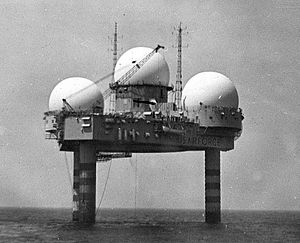Texas Tower 4
| Texas Tower 4 Air Defense Command (ADC) | |
|---|---|
 Image of Texas Tower 4 | |
 Location | |
| Coordinates | 39°48′N 72°40′W / 39.800°N 72.667°W |
| Type | Offshore air defense radar |
| Site history | |
| Built | 1956-1958 |
| Built by | |
| In use | 1958–1961 |
| Materials | Steel |
| Fate | Collapsed 15 January 1961 |
| Events | All 28 crewmen lost in collapse |
| Garrison information | |
| Past commanders | Gordon (Larry) T. Phelan |
Texas Tower 4 (ADC ID: TT-4) was a
Texas Tower 4 was one in a series of manned radar stations called "
History
Early history
Texas Tower 4 began construction in December 1956 in
In 1958, enough of the structure was complete that one
Use
Personnel from the
By early 1961, the crew had been reduced to 14 Air Force personnel and 14 repairmen due to concerns over the inability of successive repairs crews to halt the movement of the structure. Prior to the collapse, the tower had weathered two cyclones over a two-year period.
Collapse and investigation
Texas Tower 4 suffered severe structural damage during Hurricane Donna in September 1960, resulting in the decision to reduce the crew down to the level of 28. By January 1961, the tower's commanding officer, Captain Gordon Phelan, made repeated requests to evacuate the tower completely, but this was rejected on grounds that the station was constantly monitored by Soviet ships, and abandoning it would enable the Soviets to board it and capture its highly advanced radar equipment.[3] Finally at 4 pm on 15 January, after receiving numerous reports of serious damage to the station throughout the day, the Air Force authorized full evacuation of Texas Tower 4. With a heavy storm making helicopter operations impossible, Navy and Coast Guard ships were dispatched to the station. At 6:45 pm, the station sent out a distress call reporting "We're breaking up". None of the approaching ships reached it in time, and it vanished from radar contact at approximately 7:20 pm.[3] The tower had collapsed into the sea, taking with it the lives of all twenty-eight airmen and civilian contractors who were manning the station. Only two bodies were recovered.[2]
A Board of Inquiry was convened at
In May 1961, hearings chaired by Senator John C. Stennis on the collapse of the tower were held before the Preparedness Investigating Subcommittee of the United States Senate Committee on Armed Services.[7] The committee concluded that human error, on the part of engineers, building contractors, the Air Force and the Navy, was responsible for the accident. The Navy was mentioned for its supervision of the construction and repair of the tower.[8]
Current status
Today the wreckage of TT-4 remains at the bottom of the ocean, and has become a site for scuba diving. However, its depth of about 185 feet (56 m) limits access to the wreckage to advanced divers.
The site is also the location of a National Oceanic and Atmospheric Administration buoy.[9]
Units and assignments
Units:
- 646th Radar Squadron (Flight), (Operations unit based at Highlands AFS, NJ), 1 April 1959 – 15 January 1961
- 4604th Support Squadron (Texas Towers) (Logistics support unit based at Otis AFB, MA), 1 April 1959 – 15 January 1961
Assignments:
- Boston Air Defense Sector, 1 April 1959 – 15 January 1961
See also
- List of USAF Aerospace Defense Command General Surveillance Radar Stations
References
![]() This article incorporates public domain material from the Air Force Historical Research Agency
This article incorporates public domain material from the Air Force Historical Research Agency
- ^ "The locations". thetexastowers.com. Archived from the original on 25 July 2011.
- ^ New York Times, 9 February 2011; retrieved 14 February 2011.
- ^ a b "The Texas Tower Wreck New York and New Jersey's (Wreck Valley)". Archived from the original on 20 October 2006.
- ^ "Colonel Charged in Texas Tower Fall Fatal to 28". Sarasota Journal. 22 March 1961.
- ^ "Blame laid to Colonel". The Sumter Daily Item. 10 June 1961.
- ^ "Court Martial Acquits Banks". The Evening News. 24 August 1961.
- ^ United States Senate Committee on Armed Services (1961). Inquiry into the Collapse of Texas Tower No. 4. United States Government Printing Office.
- ^ "Texas Tower Tragedy is blamed on Human Error". Sarasota Herald-Tribune. 1 April 1962.
- ^ "Station 44066 – Texas Tower #4 – 75 NM East of Long Beach, NJ". National Oceanic and Atmospheric Administration. Retrieved 16 January 2014.
- Winkler, David F. (1997), Searching the skies: the legacy of the United States Cold War defense radar program. Prepared for United States Air Force Headquarters Air Combat Command.
- A Handbook of Aerospace Defense Organization 1946–1980, by Lloyd H. Cornett and Mildred W. Johnson, Office of History, Aerospace Defense Center, Peterson Air Force Base, Colorado
- Information for Texas Tower No.4 (Unnamed Shoal)
- The Texas Towers
External links
- Gallery of the construction of the tower
- "Failure Analysis of Texas Tower 4" (PDF). Offshore Technology Conference. 2002. Archived from the original (PDF) on 3 July 2014.



